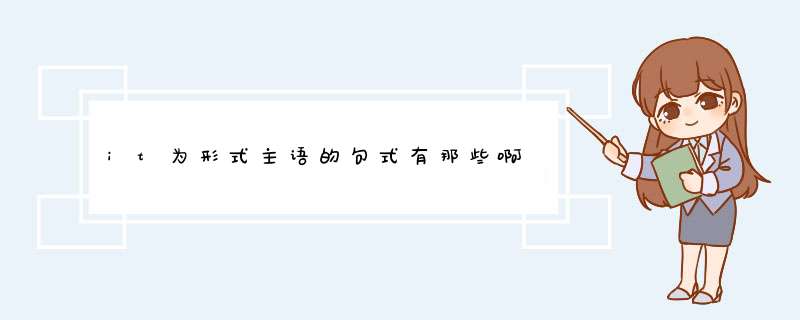
it所有格是it's。
名词所有格用来表示所有关系,一般用's和of来表示名词的所有格。与所有格相对,不带's词尾的是名词普通格。
单数名词和不以-s结尾的复数名词在词尾加’s(以s结尾的只需加’)构成所有格,主要用于有生命的东西。例如:用于表示时间的名词后tomorrow's weather(明天的天气),two days' journey(两天的旅行)
it's相关资料
凡不能加's的名词,都可以与of构成短语,来表示所有关系。(表示无生命的东西的所有关系)例如:Does anyone know the title of the novel?
有谁知道这部小说的名字?
如果名词后面有一个较长定语,尽管名词表示有生命的东西,也可以用这种所有格形式。
例如:Did you listen to the speech of the President Clinton over the radio?
你听了克林顿总统的广播讲话了吗?
it的复数形式是:they或者是them。因为it可能是人称代词主格;也可能是人称代词宾格。
it
1、(指提到过的或正在谈论的动物或事物)它
used to refer to an animal or a thing that has already been mentioned or that is being talked about now
‘Where's your car’ ‘It's in the garage’
“你的汽车在哪儿?”“在车库里。”
Did you see it
你看见它了吗?
Start a new file and put this letter in it
建立一个新档案,把这封信放进去。
Look! It's going up that tree
瞧!它正在往那棵树上爬呢。
We have $500 Will it be enough for a deposit
我们有500元。够不够作押金?
2、(指婴儿,尤指性别不详者)
used to refer to a baby, especially one whose sex is not known
Her baby's due next month She hopes it will be a boy
她的孩子该下个月出生。她希望会是个男孩。
3、(指已知或正在发生的事实或情况)
used to refer to a fact or situation that is already known or happening
When the factory closes, it will mean 500 people losing their jobs
工厂如果关闭,就意味着500人要失业。
Yes, I was at home on Sunday What about it (= Why do you ask)
是的,我星期天待在家里。怎么了?
Stop it, you're hurting me!
住手,你把我弄疼了!
4、(用以明确身份)
used to identify a person
It's your mother on the phone
是你母亲来的电话。
Hello, Peter, it's Mike here
喂,彼得,我是迈克。
Hi, it's me!
嗨,是我!
Was it you who put these books on my desk
是你把这些书放在我桌子上的吗?
5、(用作形式主语或形式宾语,而真正的主语或宾语在句末)
used in the position of the subject or object of a verb when the real subject or object is at the end of the sentence
Does it matter what colour it is
它是什么颜色重要吗?
It's impossible to get there in time
不可能及时到达那里。
It's no use shouting
喊也没有用。
She finds it boring at home
她觉得待在家里无聊。
It appears that the two leaders are holding secret talks
看来两位***正在进行密谈。
I find it strange that she doesn't want to go
她居然不想去,我觉得奇怪。
当代英语中,通常用it 做形式主语,将不定式和动名词置于谓语后面,特别是主语较长时,或在一些习惯用法中。
1) 谓语是系表结构(be + 形容词 / 名词)时,常将不定式后置,构成句型 “it + be + 表语(形容词 / 名词)+ 不定式”。
例 1 It is my duty to care for that patient
照料那位病人是我的职责。(做主语的不定式to care for that patient 后置,it 为形式主语)
例 2 It is not an easy thing to master a foreign language
掌握一门外语不是件容易的事。
例 3 It isn’t right to speak ill of someone behind his back
在别人背后说坏话是不对的。
2) 当谓语是 take,make,pay,cost ,require, feel,need 等动词时,或者是与情绪有关的动词 delight,amuse,excite,annoy,irritate 等时,习惯上常用 it 做形式主语,并将不定式后置。
例 1 It takes only ten minutes to get there
到那儿只需十分钟。
例 2 It pays to be honest
诚实是不会吃亏的。
例 3 It feels good to stay away from the crowded city
能远离拥挤的城市,感觉真不错。
例 4 It annoyed her to see someone spit on the ground
看见有人随地吐痰让她很生气。
3) 同不定式一样,动名词也可用于“it + be + 表语 + 动名词”句型中,二者的区别可参见10.2.2 中1)的论述。下面两组句子没有多大差异。
例 1 A) It is a waste of time to argue with him
B) It is a waste of time arguing with him
和他争辩是浪费时间。
例 2 A) It is worthwhile to discuss this again
B) It is worthwhile discussing this again
这一点值得在讨论一下。
4) 但表语是(of)no use,not any use,not the slightest use, no good, not much good,fun等时,常用动名词(不用不定式)做主语并后置,用 it 做形式主语。
例如 It’s no use crying over spilt milk
覆水难收。
5) 动名词还可在 there be 句型中做主语(不能用不定式),常见形式为 “there is no + 动名词”或 “there is no / any + 名词 + 动名词”。
例 1 There is no denying the fact
事实无可否定。
例 2 There isn’t any use trying again
再试也没用
你还可以参考>
以上就是关于it的所有格是什么全部的内容,包括:it的所有格是什么、it的复数形式是什么、it为形式主语的句式有那些啊等相关内容解答,如果想了解更多相关内容,可以关注我们,你们的支持是我们更新的动力!
欢迎分享,转载请注明来源:内存溢出

 微信扫一扫
微信扫一扫
 支付宝扫一扫
支付宝扫一扫
评论列表(0条)